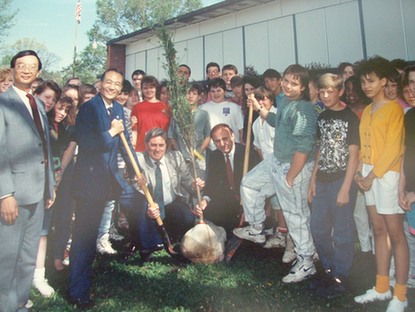| Finding the Ties That Bind Through Educational Exchange
By XIE QIGANG
It was in November 1973 that I first became involved with educational exchange between China and the US. At the time I was a staff member of the Science and Education Team of the State Council. It was my duty to meet the American Delegation on Early Childhood Education at the Guangzhou Railway Station after they arrived in China. They were the first such delegation on education to come following President Nixon's groundbreaking visit to the country.
As liaison, I spent the next half a month with the 13 professors, forming friendship with them all. When they left from that same station, I hugged each of them as we shed tears and said goodbye. William Kessen, the leader of the group, handed me an envelope containing 13 cards. Those were not cards, but 13 sincere hearts that I still treasure to this day. Later I was excited to receive several copies of the book Childhood in China, which the professors had written back home. Signatures of thanks adorned the inside front cover. Everyone was looking forward to normalization of diplomatic relations between the two countries.
Six years later, an official diplomatic relationship was finally established. And I had an opportunity to take part in the first visit the Minister of Education of the PRC paid to the U.S. After the trip, I was put in charge of the government-sponsored study-abroad project – working directly for the educational exchange. I witnessed the starting phase of the project and the U.S. Embassy, I have to say, was a great help – providing useful information that made the work processes much more fluid.
My understanding of the American tertiary education system was deepened during this period, as I visited almost every renowned university in the U.S. over a four year period. In 1981, by invitation of the U.S. Agency for International Exchange (now the U.S. Information Agency), I attended a symposium on American education held in the Philippines, which enhanced my understanding of the system still further.
 |
|
Xie Qigang (second left, front row) planting a memory tree with the principal and state governor's representative at a West Virginia high school in 1990. |
In 1984 I was appointed a counselor in the Chinese Embassy to the U.S., and witnessed the rapid development of bilateral relations. Chinese President Li Xiannian visited the U.S., followed by several more high-level visits. In charge of educational exchange, I maintained close relations with many organizations and companies as well as the U.S. government. Aside from schools, I visited places of interest like Boeing, MacDonnell-Douglas and the world's biggest oil drilling platform – some of most unforgettable experiences in my life.
In early 1991 I was promoted to minister-counselor and continued my work in that capacity till 1994. Although the Sino-U.S. relations had hit a rough patch during this period, I still had a cordial working relationship with my American counterparts. The thing I treasure most about my days in the U.S. was making so many good friends, with whom I still keep in touch regularly.
When I returned to China in 1995, I prepared to set up the China Scholarship Council, in which I later worked as secretary-general. Looking back on it, educational exchange programs went through hard times but eventually developed into a prosperous market. It was 1847 when Rong Hong left for the U.S. to become the first Chinese student to study abroad; it was almost a quarter of a century later before the Chinese government dispatched new groups of students to the U.S. In 1979, the Chinese government resumed its educational exchange with the U.S. once again, marking the start of dramatic and exponential growth in the area. In 2008, over 300,000 Chinese students went to study at American universities.
Students who have studied abroad are now integrated into the mainstream of every sector in Chinese society, underlining the importance of international educational exchange. Unfortunately, the number of reciprocal American students studying in China is far fewer. Had hundreds of thousands of American students seized the opportunity to get to know China just as their Chinese counterparts have in the U.S., relations between our two countries would be better. It would also put the Sino-U.S. strategic partnership on a firmer foundation.
Now retired, I still follow events on the other side of the Pacific. As part of my daily ritual I read the Washington Post and New York Times online, and the U.S. Embassy's journal New Exchange is also a favorite of mine. I am proud to have contributed to the friendship between China and the U.S. over the last three decades, and I am highly confident about the future – the world is becoming snugger; so is the Sino-U.S. relationship. | 